What type of content do you primarily create?




Recording yourself presenting a PowerPoint is one of those tasks that sounds simple until you try it. Suddenly you're juggling screen capture, webcam framing, and audio quality while trying to deliver content naturally and not fumble between slides. It's a technical obstacle course most of us weren't trained for.
The available tools often don't help. Most seem designed by people who've never actually recorded themselves—either too complex or too limited. But creating professional-looking recordings doesn't require technical expertise or fancy equipment, despite what many tutorials suggest.
Whether you're a teacher creating lessons that won't put students to sleep, a marketer making product demos people actually watch, or someone looking to appear composed on camera, we've got you covered. This guide offers seven practical ways to record yourself presenting a PowerPoint—balancing quality with real-world usability.
TL;DR:
- Recording yourself presenting a PowerPoint can be challenging, but it doesn't have to be reserved for experts.
- Video recording offers unlimited reach, repurposing opportunities, and a more engaging experience.
- Use PowerPoint's built-in recording feature or tools like Descript for a polished presentation.
- Other tools like Zoom, Loom, OBS Studio, Clipchamp, and Quick Time Player can also be used for recording.
- Tips include practicing your script, using slide notes, ensuring high-quality audio and lighting, and incorporating storytelling techniques.
Why video record yourself presenting a PowerPoint?
Video recording yourself presenting a PowerPoint offers several advantages: you can share your presentation with people who couldn't attend live, create training materials that can be viewed anytime, and deliver your message with both visual slides and your personal presence for maximum impact.
- Unlimited reach: Unlike in-person presentations confined to a specific time and location, recorded videos allow your message to reach audiences globally at their convenience.
- Repurposing opportunities: Recorded presentations can be repurposed as evergreen content across multiple platforms, such as social media, online courses, webinars, and internal training materials, maximizing their value.
- Personal and engaging: Recording yourself narrating a presentation adds a personal touch and dynamic element that static slides alone cannot replicate. Your viewers can see and hear you deliver the content, creating a more immersive and engaging experience.
Recording narration and slide timings in PowerPoint
PowerPoint lets you record voice narrations and track how long you spend on each slide, making it easier to create a smooth playback experience. To start, open the Record Slide Show option from the Slide Show tab. If you need a pause, press Alt+P to halt the recording or Alt+S to stop altogether according to Microsoft. After finishing, preview your work to clear out any missteps or timing errors. This approach is helpful if you want fully narrated slides without needing extra editing software. Finally, choose an export option that retains your recorded narrations, so you can share your timed PowerPoint video with viewers anywhere.
How to record yourself presenting a PowerPoint with the app
Built-in recording feature in PowerPoint
1. Open the PowerPoint slide you want to record.
2. Click on the Record tab of the top toolbar.
 |
3. Click on the Record button and choose from any of the following options:
- From Current Slide
- From Beginning
4. You'll see the PowerPoint screen recording window.
 |
5. Select the microphone and camera from the icon on the top-right.
6. Click the Stop and Replay buttons to end or replay your recording.
7. To export your presentation's recording, click Export to Video within the Recording tab.
 |
Benefits: Easy to use, no external tools needed
Limitations: Limited editing capabilities.
How to record yourself presenting a PowerPoint with Descript
While PowerPoint's built-in recording features are helpful for basic video recording of your presentations with your face included, they may not produce the refined result you want. That's where Descript comes in handy.
It's a whole production studio at your fingertips, with video recording, transcription, and editing capabilities, ready to transform dull PowerPoint slides into an engaging video presentation with your face and narration included. Descript also has a built-in screen recorder.
You can use Descript on Windows, Mac, or even straight from your web browser.
Here's a step-by-step guide to video recording yourself presenting a PowerPoint with Descript.
Set up your screen recording
1. Install and open Descript. At the top of the editor, click and open the Record panel.
2. Select Screen.
3. Set Recorder settings:
Adjust the default recording settings to your liking, including the transcription language, the maximum recording resolution, and more.
4. Set recording options. Choose which audio and video sources to record (e.g., microphone, computer audio, camera). Remember to turn the camera on to capture your talking head video alongside your PowerPoint presentation. This creates a picture-in-picture effect with both your face and slides visible.
5. Click the Additional Settings icon for more recording options like keyboard shortcuts, setting recording timers, and configuring your webcam position when recording yourself presenting PowerPoint.
- Studio Sound (Optional): Enhance audio quality with noise reduction and background removal
- Transcription (Optional): Enable automatic transcription for easier editing
- Recording separate audio tracks
6. Add (optional) Speaker labels for each audio track (e.g., "Narrator," "Expert") by typing them in the text box next to your audio inputs.
 |
Capture your screen recording
1. Select the right recording option: Record your entire screen to capture the full PowerPoint presentation, or select a specific window to record just your presentation while keeping other windows private.
- Recording into script: Choose this if you haven't recorded anything yet.
- Replace selection: Choose this if you already have a script and want to replace a specific section with a new recording.
- Record new layer: Pick this for recording your video as a new layer on top of an existing recording.
2. Click Record at the bottom of the Record panel.
3. Drag over the area of your screen you wish to record. Click Start Recording. Press Space to start recording the full screen.
4. Click Stop to finish recording
Bonus: Descript creates separate tracks for camera, microphone, and computer audio. You can edit each track individually for more precise control over how your face appears alongside the PowerPoint slides.
Pro tips:
- Do a short test recording to ensure everything is set up correctly.
- Set your recording to transibe for easier editing.
Editing and polishing your PowerPoint recording in Descript
Descript's AI video editing tool makes it a breeze to trim, cut, and splice your video footage, ensuring a seamless flow from start to finish. You can add smooth transitions and other visual effects to make your presentation pop. This is especially useful when you've recorded yourself presenting a PowerPoint and want to enhance the viewer experience.
Here's a glimpse of how to edit and polish your PowerPoint recording in Descript:
Edit your recording like a doc
Did you make a mistake during a slide transition or stumble over your words while recording yourself presenting PowerPoint? No problem. Just delete those sections in the text transcript (created automatically by Descript) and the video will adjust to match, removing both your face and voice for that segment.
Remove filler words
Sound smoother and more confident by easily removing filler words like "um" and "uh" from the transcript.
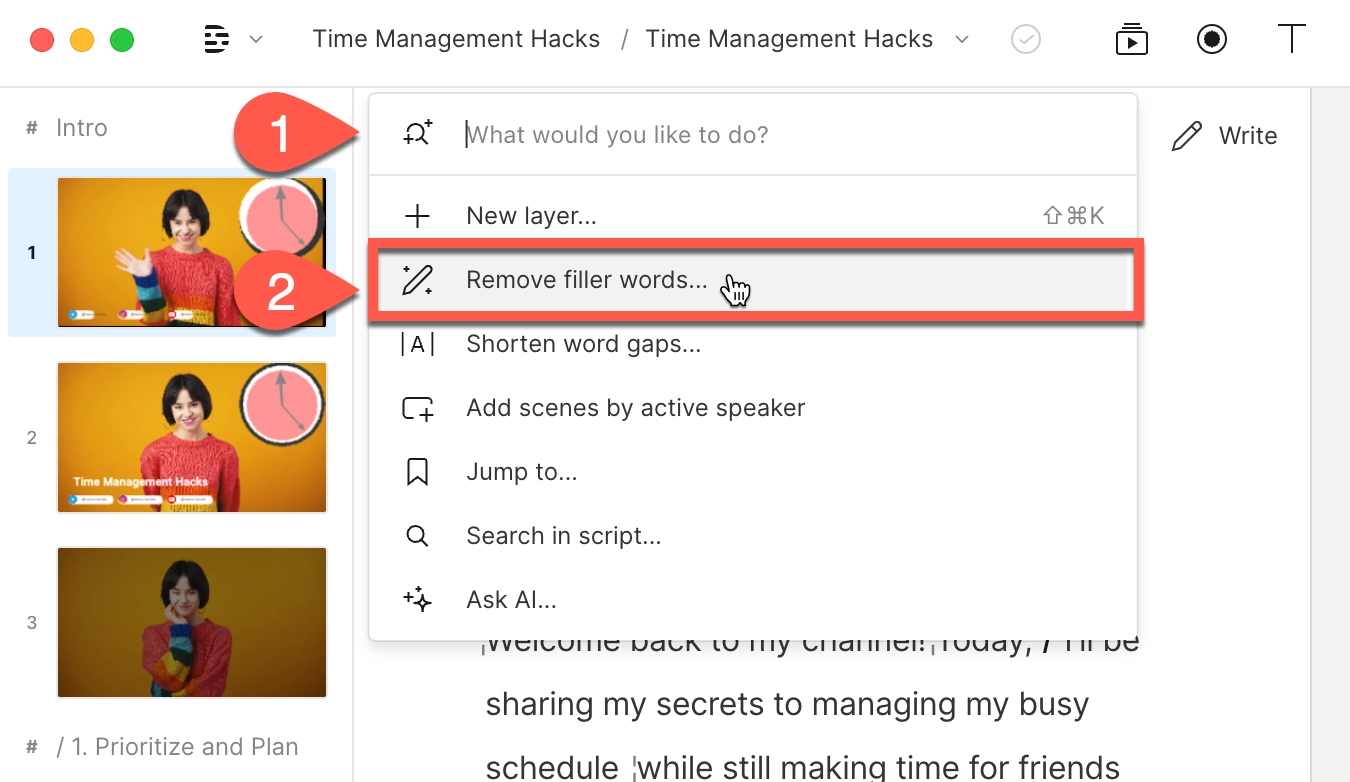 |
Fix voiceover mistakes by typing
Didn't nail your delivery on a specific slide while recording yourself presenting PowerPoint? No need to start from scratch! Descript's Overdub feature lets you simply type in the correct narration and replace the audio on that slide with AI voice cloning. Your face video remains intact while the audio is improved.
 |
Boost video quality and engagement: Use Descript's Studio Sound to enhance your voice recording quality and Eye Contact feature to make it appear like you're looking directly at your audience when recording yourself presenting PowerPoint.
- Crisp up audio quality by reducing background noise and room reverb with the AI-powered Studio Sound feature.
 |
- Replace your background completely with the Green Screen Video Editor—look like you're presenting in a sleek studio or broadcasting from a beach.
- Enable Eye Contact simulation with AI, so it appears you're making direct eye contact with viewers, even if you're looking or reading something off-camera.
Exploring PowerPoint’s newer recording studio
Microsoft 365’s updated Recording Studio offers several enhancements that can simplify the process of capturing your presentation. It includes a teleprompter view to help keep notes directly in your line of sight when recording without losing eye contact. Users can also blur the camera background for a more professional appearance or delete and preview recordings on each slide instantly. Another advantage is the ability to export completed videos in various formats, giving you flexibility in where and how you share them. These enhancements make it easier to produce polished slide recordings without juggling multiple apps or complicated workflows. By leveraging these newer features, you can create a refined presentation that looks modern and consistent.
Other ways to video record yourself presenting a PowerPoint
1. Zoom
Use Zoom's meeting recording feature to record yourself giving a PowerPoint presentation. Start a Zoom meeting with yourself, share your PowerPoint window, and enable recording. Your webcam video will appear in a small window alongside your slides, allowing viewers to see both your face and presentation simultaneously.
2. Loom
Loom is a handy screen recording tool that also offers a webcam overlay for recording yourself presenting PowerPoint. Launch the Loom app or Chrome extension and set it to record your screen and webcam. Expect high-quality recordings but no advanced editing features. The free plan offers only five minutes of recording at a stretch, which may limit longer presentations.
3. OBS Studio
OBS Studio is a free, open-source screen recorder/streaming software with a steeper learning curve. It's popular among advanced or tech-savvy users who need granular customization and control.
To record your presentation with your face visible, add a "Screen Capture" source to capture your PowerPoint window and a "Video Capture Device" source for your webcam. You can adjust the size and position of your webcam feed to create a professional picture-in-picture effect.
4. Clipchamp: Recording natively in Windows
You can use Microsoft's Clipchamp, the built-in screen recorder and video editor for Windows, to simultaneously capture your computer screen, webcam, and audio for recording yourself presenting a PowerPoint. It's also available as a browser-based app. You can record up to 30 minutes on screen and webcam recordings, making it suitable for most presentations.
Users can also adjust the screen and webcam recordings in the editing timeline separately, allowing you to resize your face video or move it to different positions on the screen throughout your PowerPoint presentation recording.
 |
5. QuickTime Player: Recording natively on Mac
Use Mac's Quick Time Player to record yourself presenting your PowerPoint presentation. It's not as straightforward as the other options on this list for capturing both your face and slides, so here's a quick guide to help you out:
- Launch Quick Time Player.
- Select File and go to New Movie Recording.
- You'll be recording your entire screen in addition to recording your face, so adjust the size and location of the recording window so that it's in a nonintrusive corner of your PowerPoint.
- Go to View and select Float on Top.
- Next, go to File and select New Screen Recording.
- On the menu that appears, select Record Selected Portion and drag a border around your PowerPoint and the webcam recording window.
- Press Record and start presenting.
- You can adjust the video quality and the audio source in the webcam recording window.
How to turn your PowerPoint presentation slides into a video
Did you know PowerPoint lets you save your presentation as a video, too?
Here's a breakdown of the two ways you can do so—keeping all the presentation elements (narration, animation, pointer movements, timings, and so on) intact in the presentation itself. However, note that these methods don't include recording your face alongside the slides like the previous options.
Save your PowerPoint presentation as a video
This creates a separate video file (MP4 or WMV) that anyone can play, even without PowerPoint.
Follow these steps:
- Save your presentation
- Go to File > Export > Create a Video
- Choose the video quality (higher quality means bigger file size). Here's a quick guide:
- Ultra HD (4K): Best for large screens (if you have Windows 10+)
- Full HD (1080p): Great for computers and TVs
- HD (720p): Good for streaming online or on DVDs
- Standard (480p): Smallest size, good for phones
4. Decide on narration and whether to include webcam video (note: PowerPoint's webcam recording features vary by version and may not be available in all versions)
- If you haven't recorded yourself talking, choose "Don't Use Recorded Timings and Narrations" from the dropdown menu
- If you have a recording, choose "Use Recorded Timings and Narrations." You can also set how long each slide shows for (default is 5 seconds)
5. Click Create Video
6. Name your video, pick a folder to save it in, and choose a file type (MPEG-4 or Windows Media Video)
Creating the video might take a while, especially for longer presentations. You can even leave it running overnight. Once done, find your video in the chosen folder and double-click to play it.
Save your PowerPoint presentation as a slideshow
This saves your presentation as a special file (PPSX) that starts playing automatically on full screen when opened. It only works with PowerPoint.
Here's how it works:
- Make sure your presentation is saved (regular PowerPoint file)
- Go to File > Save As.
- Pick a folder to save the slideshow in.
- Under Save as type, choose PowerPoint Show (*.ppsx).
- Click Save.
Now when someone opens the file, it will automatically play the slideshow.
Pro tips for making better video PowerPoint presentations
Practice your script
Recording a flawless PowerPoint video rarely happens in one take. The key is practice.
Record practice run-throughs and watch them back. Make notes on areas that need improvement or parts lacking clarity. The more you drill your script, the more confident and natural you'll sound in the final recording.
Take advantage of PowerPoint's built-in Speaker Coach. The feature shows you whether your pace is too fast or slow, your use of filler words like "um," and suggestions to improve your voice modulation. This helps you deliver a more polished narration when recording yourself presenting your PowerPoint.
Use slide notes for coherent delivery
Wouldn't a personal teleprompter make presentations so much easier? That's what slide notes are for.
Having your thoughts and talking points organized within your PowerPoint file lets you have all crucial information and prompts readily available when recording.
Go ahead and add detailed notes or even a full script for each slide. This will help you stay on track and provide a handy transcript reference if you need to do any editing or voiceover work in post-production.
Use high-quality audio equipment or turn on Studio Sound
Poor audio recording quality is a surefire way to make even the most visually polished video feel amateurish. Do your presentation justice by investing in a decent external or Bluetooth microphone and audio interface to capture clear voiceover audio.
If you must use a built-in mic, record in a quiet environment to minimize background noise pickup. Or better yet, pair up with an AI-powered audio enhancement tool like Descript's Studio Sound, which reduces background noise, reverb, and other artifacts.
Ensure a clean background and even lighting
Ditch cluttered backgrounds. You want people to focus on the content of your PowerPoint and not be distracted by the funny shapes and colors in your video.
Your video lighting and framing matters, too. Position yourself facing a natural light source or bring supplemental video lighting to eliminate weird shadows and squinting-level glare.
Look directly into the camera or turn on Eye Contact
Looking directly into the camera is essential to create a sense of connection with the audience when video recording yourself presenting a PowerPoint. Position your webcam or camera at eye level and imagine you're talking to a friend. If you're using Descript, enable the Eye Contact feature to auto-adjust your gaze towards the camera, making your presentation more engaging.
Additional recording tips
- Dress professionally and maintain a good posture to project confidence and authority.
- Use visuals, animations, and multimedia elements to enhance your presentation and keep your audience engaged.
- Consider adding closed captions or subtitles to your video for better accessibility and engagement, especially for those watching without sound.
- Speak clearly and at a moderate pace, using vocal variety to emphasize key points and maintain interest.
- Incorporate storytelling techniques, real-life examples, or personal anecdotes to make your video presentation more relatable and memorable.
Take your PowerPoint presentations from amateur to amazing
Recording yourself virtually presenting a PowerPoint allows you to distribute your message using the most engaging type of content: video. And there are many screen recording tools out there that can capture your screen and web camera footage with just a few clicks, giving viewers both your facial expressions and slide content simultaneously.
But how do you stand out?
By focusing on the presentation's depth, your delivery, and the video's quality. The first two are the bare minimum to communicate your message effectively.
But the right screen capture software and all-in-one video creation tool like Descript can help you with the third. Use the tool to improve the quality of your recorded PowerPoint presentations with features specifically designed to enhance how you look and sound when presenting on camera.
With Descript, it's easier than ever to record your screen, polish up the audio, and create stunning visuals all in one place. So why wait?
Sign up for Descript today and simplify your workflow while creating a PowerPoint presentation video that sticks with your audience in the long term.
Frequently asked questions about recording PowerPoint
How do you make a presentation video with your face?
To create a presentation video with your face visible alongside PowerPoint slides, follow these steps: set up your webcam, position it at eye level, ensure good lighting on your face, open your screen recording software, select both screen and webcam as recording sources, and arrange the webcam overlay in a position that doesn't obscure important slide content.
- Open your presentation in PowerPoint.
- Go to the Slide Show tab.
- Click on Record and choose From Current Slide or From Beginning.
- Choose your microphone and camera by clicking on a sound icon on the top-right.
- Start recording by clicking on the record button.
- Speak into your microphone to narrate the presentation.
- Your webcam will capture your face during the recording.
- Click Stop when you finish recording.
- Export your recorded presentation by clicking on File> Export>Create a video.
How do you present yourself in PowerPoint?
To present yourself effectively when recording a PowerPoint with your face visible, follow these steps: dress professionally, maintain good posture, look directly at the camera (not your screen), use hand gestures sparingly, speak clearly with good pacing, practice your delivery beforehand, and consider using Descript's Eye Contact feature to enhance audience connection.
- Determine the key information to include in your presentation.
- Design and prepare your PowerPoint slides with a cohesive theme.
- Craft a compelling introduction to engage your audience.
- Tailor your presentation to different time constraints for flexibility.
- Capture the audience's attention before you begin speaking.
Can I blur my background while recording in PowerPoint?
Yes. Microsoft 365’s Recording Studio allows you to blur your camera background for a cleaner look according to Microsoft. This feature can help keep the focus on your slides and narration rather than what’s behind you. Look for the camera settings in the Recording Studio and select the blur option. Once activated, your background appears diffused to viewers while you remain clear in the frame.
Does PowerPoint support real-time captions during my recording?
Yes. PowerPoint for Microsoft 365 supports real-time automatic captions or subtitles when you present based on Microsoft documentation. This feature can improve accessibility by displaying on-screen captions as you speak. You can also adjust the position, size, and color of these captions. Enable or disable captions at any point in Slide Show or Presenter View for better audience engagement.








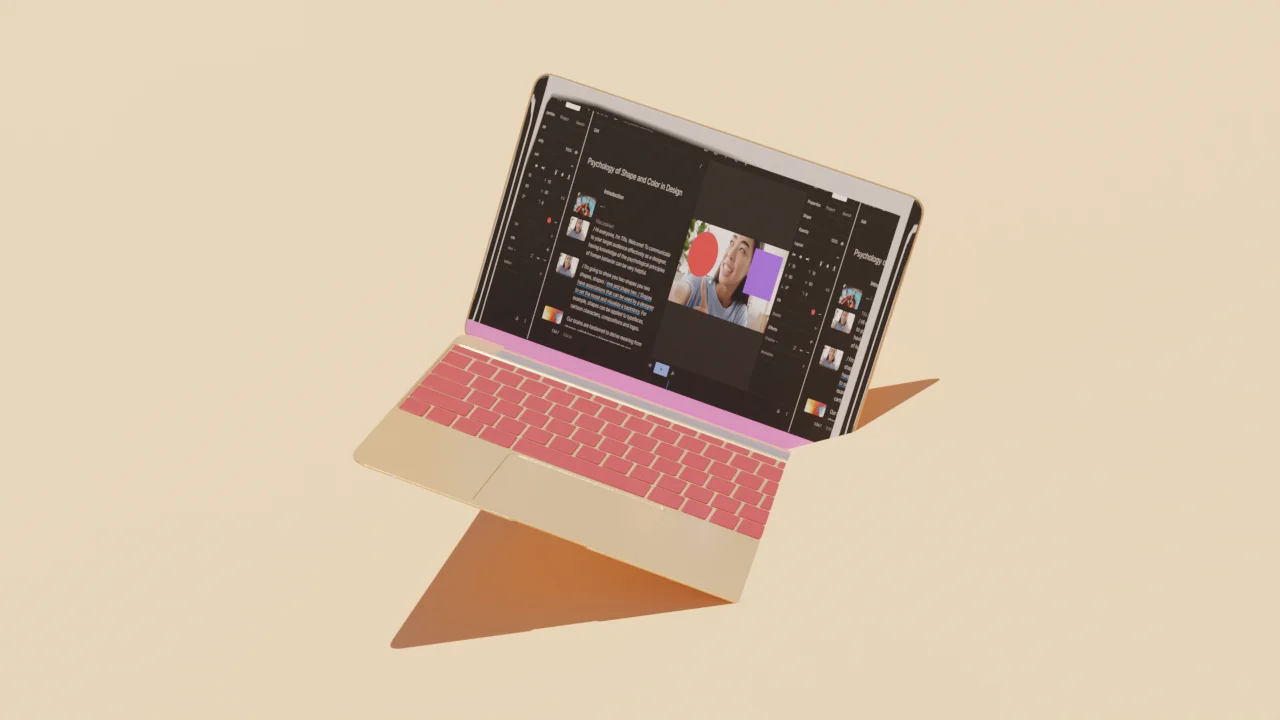







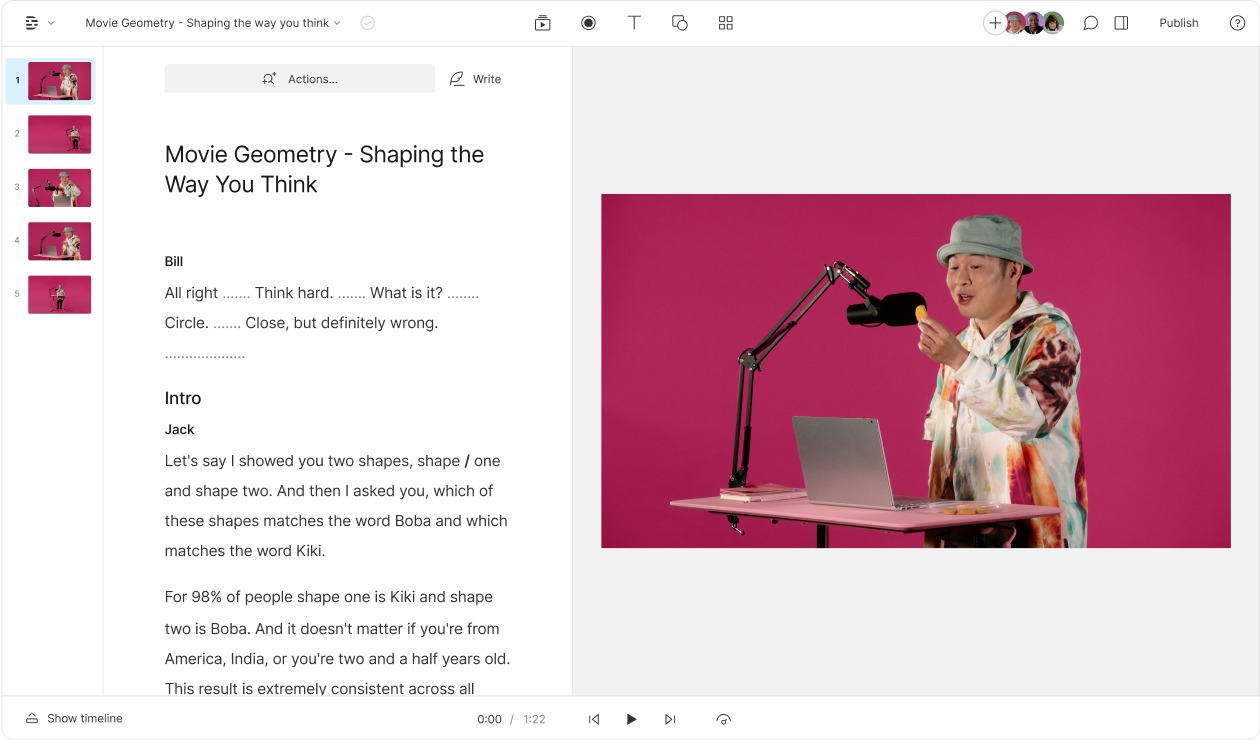











%201.svg)





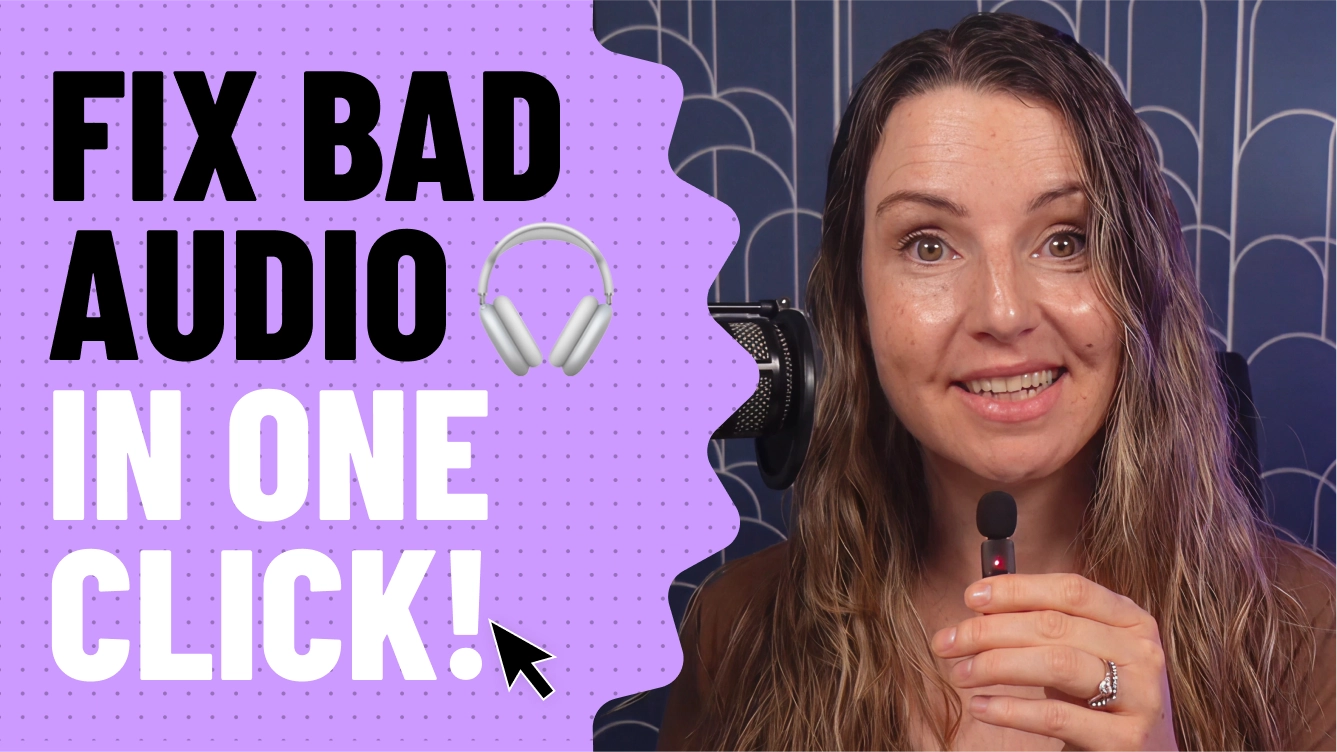



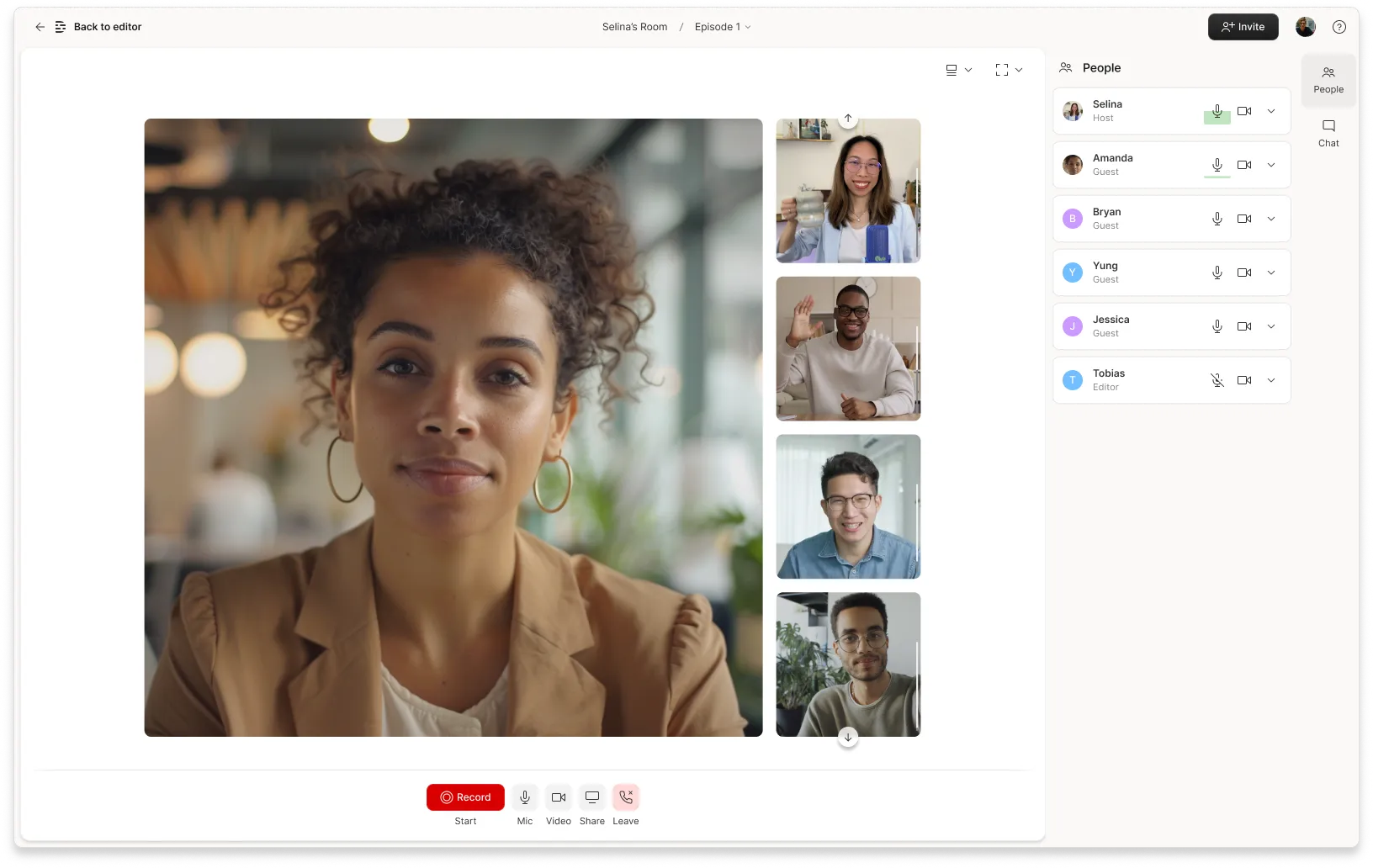





%20(1).JPG)

